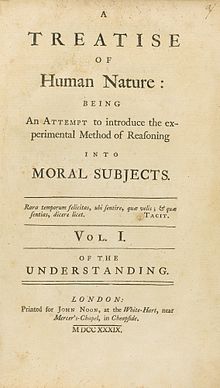by ALISON GOPNIK
 IMAGE/Wikipedia
IMAGE/Wikipedia
Everything that had defined me was gone. I was no longer a scientist or a philosopher or a wife or a mother or a lover.
My doctors prescribed Prozac, yoga, and meditation. I hated Prozac. I was terrible at yoga. But meditation seemed to help, and it was interesting, at least. In fact, researching meditation seemed to help as much as actually doing it. Where did it come from? Why did it work?
I had always been curious about Buddhism, although, as a committed atheist, I was suspicious of anything religious. And turning 50 and becoming bisexual and Buddhist did seem far too predictable—a sort of Berkeley bat mitzvah, a standard rite of passage for aging Jewish academic women in Northern California. But still, I began to read Buddhist philosophy.
…
In his Treatise, Hume rejected the traditional religious and philosophical accounts of human nature. Instead, he took Newton as a model and announced a new science of the mind, based on observation and experiment. That new science led him to radical new conclusions. He argued that there was no soul, no coherent self, no “I.” “When I enter most intimately into what I call myself,” he wrote in the Treatise, “I always stumble on some particular perception or other, of heat or cold, light or shade, love or hatred, pain or pleasure. I never can catch myself at any time without a perception, and never can observe any thing but the perception.”
…
But here’s Hume’s really great idea: Ultimately, the metaphysical foundations don’t matter. Experience is enough all by itself. What do you lose when you give up God or “reality” or even “I”? The moon is still just as bright; you can still predict that a falling glass will break, and you can still act to catch it; you can still feel compassion for the suffering of others. Science and work and morality remain intact. Go back to your backgammon game after your skeptical crisis, Hume wrote, and it will be exactly the same game.
In fact, if you let yourself think this way, your life might actually get better. Give up the prospect of life after death, and you will finally really appreciate life before it. Give up metaphysics, and you can concentrate on physics. Give up the idea of your precious, unique, irreplaceable self, and you might actually be more sympathetic to other people.
How did Hume come up with these ideas, so profoundly at odds with the Western philosophy and religion of his day? What turned the neurotic Presbyterian teenager into the great founder of the European Enlightenment?
In my shabby room, as I read Buddhist philosophy, I began to notice something that others had noticed before me. Some of the ideas in Buddhist philosophy sounded a lot like what I had read in Hume’s Treatise. But this was crazy. Surely in the 1730s, few people in Europe knew about Buddhist philosophy.
Still, as I read, I kept finding parallels. The Buddha doubted the existence of an omnipotent, benevolent God. In his doctrine of “emptiness,” he suggested that we have no real evidence for the existence of the outside world. He said that our sense of self is an illusion, too. The Buddhist sage Nagasena elaborated on this idea. The self, he said, is like a chariot. A chariot has no transcendent essence; it’s just a collection of wheels and frame and handle. Similarly, the self has no transcendent essence; it’s just a collection of perceptions and emotions.
“I never can catch myself at any time without a perception.”
That sure sounded like Buddhist philosophy to me—except, of course, that Hume couldn’t have known anything about Buddhist philosophy.
Or could he have?
The Atlantic for more
